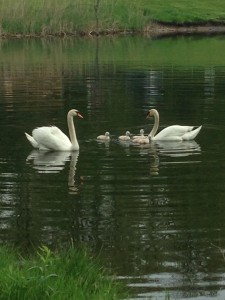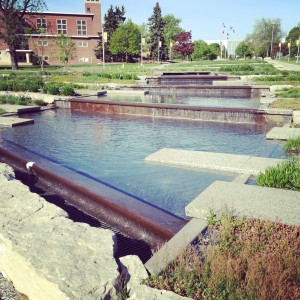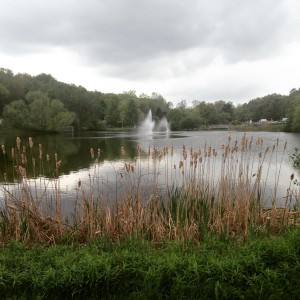Most of you reading this probably already know from various other mediums that I attended the International Congress on Medieval Studies at Kalamazoo this past weekend. It was indeed as amazing as I had envisioned it would be, and even though I unfortunately could not see or hear everyone I would have wanted (a sentiment I think the majority of those at the conference felt), the panels I did attend were brilliant and left me wanting to explore many different topics. Nevertheless, despite having learned much from the papers I heard, those are pieces I won’t be discussing – they belong to others who have worked long hours on them, and I will leave to them the task of disseminating their ideas however they so choose. I have not yet fully mastered the art of live tweeting, and I most certainly do not want to now, days later, misrepresent anyone’s ideas. However, there are certain general ideas I pulled from the conference as a whole, and would love to share those instead.
Although this was my first time attending, I have paid close attention to the conference in the past, and one theme that I felt reemerged more than ever was the questioning of our presence in this venue; it was never about why we are here, but what we are doing. And more importantly, what are we? Perhaps a silly question since we are clearly a slew of medievalists attending a conference geared towards our interests, but therein surfaces the question of what constitutes a medievalist. Thus the inquiry that emerged over and over again brought to question our very ontology, and as I bobbed in and out of various panels trying to form a cohesive interpretation of what I was witnessing, I realized not only that there is no one way of defining this conference, but also that that is a wonderful thing in and of itself.
I am in no way negating the larger umbrella term “medieval” under which this conference has been operating for fifty years, or the ways in which this term is used to define our collective field, but as was openly discussed via different means, the term itself only serves to loosely define a certain time period in a selective hemisphere, namely Western Europe from 500 to 1500 A.D.. Needless to say this is a rather narrow approach that no longer suites our larger purposes. However, unlike some who have proposed doing away with the term altogether, I think the word is ready to enter yet another etymological phase and become reconceptualized in accordance to our current needs.
Further, those of us who make use of the term to define our studies should be the ones spearheading this movement. Instead of finding a new nomenclature for our research, we can widen the scope of that which is in existence. In other words, simply because medieval studies haven’t yet focused on different parts of the world, or even delved into certain disciplines, does not mean that medieval studies can’t breach these boundaries. It is not about finding a new word to call ourselves, but redefining the ways our current vocabulary operates. And in doing so we maintain control of the context in which medieval studies flows and for those of us who do bear an anxiety about the word’s future we can rest assured it’s power will be harnessed towards future academic endeavors internationally and interdisciplinary, and will not become misappropriated or abused. We can continue to kindly correct those who misuse the term, and continue to educate others who wish to know more about its variable meanings.
Coming from a literature background it is perhaps easy for me to discuss word usage, and rely on past instances of language change to better understand and talk about the very changes we are witnessing today. However, I don’t believe this is simply a philological question, but rather one that permeates into true interdisciplinary territories. It is a philosophical question that explores the fundamental existence of “medieval” as a concept. It is a question for historians to trace this concept and negotiate how it operates to define various junctions in our past. It is a question for geographers who must rethink and redraw our world maps when confronted with medieval studies, adventuring beyond the borders of what once was central to the discipline. It is a question for librarians and those in manuscript studies who have in the last twenty or less years been inundated with manuscripts from territories that had previously been closed off to academia. The list of disciplines that are confronted with this question continues, and frankly I don’t believe it stops. There is no field that medieval studies has not, or cannot, infiltrate. Some might argue this becomes an issue about relevance, and I don’t necessarily disagree, but feel it is about more than that – it is about challenging axiomatic understandings of the past and using all the resources available to us to address and redraft the narrative of “medieval ____.”
Which brings me to another aspect of scholarship in general, that is not necessarily confined to medieval studies: the means of information sharing which has in recent years come a long way. The fact that you are reading this is in itself a demonstration of one such medium for distribution of ideas. I am not well known in academia for my long publication history (although that is certainly a goal), I am occasionally known for my presentations, but mostly I am known for my online presence. At almost every panel I attended someone knew me because they had encountered me online, interacted with me, read my blog, and/or were to some extent familiar with my research. For a barely-out-the-door academic this was immensely positive. A lot of my research is not yet complete, and not ready for publication. However, my blog has given me a platform to nevertheless share my ideas with others, communicate with them about my projects, obtain valuable feedback, and most importantly form connections.
Ten years ago this wasn’t possible. Five years ago it wasn’t prudent. Now it has become an almost established norm, and becoming more and more acceptable. Kzoo happens once a year. MLA happens once a year. Regional conferences happen once or twice a year. Blogging can happen as often as one can manage to produce new ideas, and others can read as much and as often as they like, providing feedback and continuing conversations well outside conference venues. Of course this does not take away from or diminish the energy of in-person interaction, or of presenting to a large room of people. Yet we cannot escape the idea that there are peripheral conversations occurring in academia well outside its walls.
A large part of these marginal, but not necessarily marginalized discussions permeate into topics such as “what is a medievalist?” but range well beyond that into far more obscure spheres with an almost self awareness that their vary existence challenges the definition of medieval studies. There is no one right subject to investigate in medieval literature, history, philosophy, musicology, etc. To devote an entire paper to the findings centered around a single word in an obscure text is no less important or interesting than, say, reconceptualizing the Canterbury Tales. These are equally fascinating topics that appeal to just as many, and often overlapping, scholars. Even as I no longer identify myself as the Anglo-Saxonist I once started out as while sitting in Donka Minkova’s Linguistics course as an undergrad at UCLA, I have not veered so far as to deny a fascination with Old English. Similarly I currently study Old French, Occitan, and Eastern European manuscripts as part of three different projects. The only importance I give one over the others has to do with completion deadlines. Nevertheless, there was a time when I thought of myself as the wrong type of medievalist. I wasn’t studying anything relevant. As I related my research to a colleague about my French female scribe and her involvement in drastically editing a manuscript within the post-vulgate Lancelot cycle he looked blankly at me and asked “who cares?” It occurred to me I wasn’t functioning in the mainstream of scholarship. Despite the praise I had received from other more advanced academics, I was certain my topic was inherently flawed. Honestly, I still have these fears, and in the last year they have been more prevalent than ever.
These last few days, as I watched others navigate their own topics it was reassuring. Many others were attempting to construct arguments on equally obscure topics and sources. While some papers given were based on or were parts of forthcoming books or articles, others were fledgling ideas searching for approval or an outlet.
And for me I suppose that that is what this conference was ultimately about – a conglomeration of academics that operate as a seemingly homogenized body with similar and simultaneously disparate interests and intentions and who continue to prove that there is no one right way to be a medievalist – a term that has a definition only in so much as we define it.








